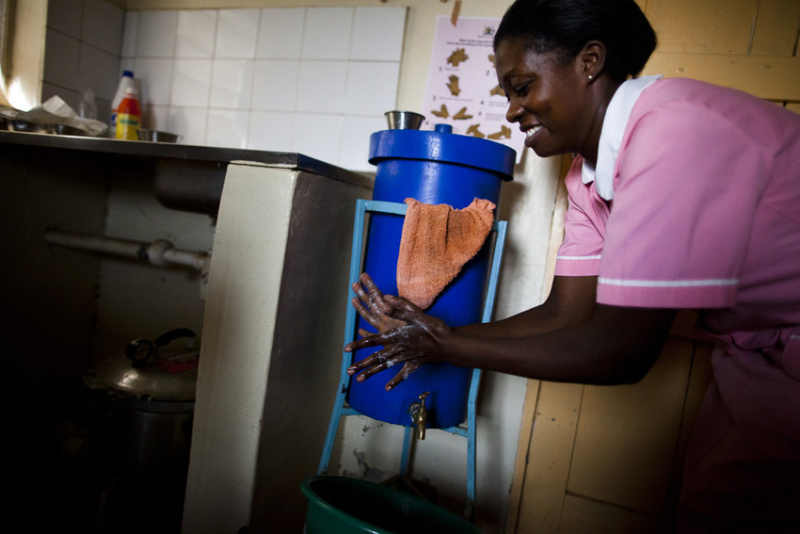Where We Work
See our interactive map


Photo by Trevor Snapp for IntraHealth International
October 15 is Global Handwashing Day and the theme is “Make Handwashing a Habit!” That's great. But what if the only water you have to wash with is dark brown?
You arrive at the health post in Southern Province, Zambia. It’s the closest facility of any kind for 100 kilometers, or four hours by car on the rough and rutted terrain. Your bum hurts from all the bumping.
Stepping out of your vehicle you see large rocks, nothing green. It’s the dry season, after all, and this year’s been especially bad as the rains started much later than usual.
You find out the wells are drying up, too. That’s what the health workers—a nurse and two community health assistants—tell you. One of their two wells is still in use to supply water for the facility. They stopped using the other one when the water turned black and thick and putrid.
The water they’re using now—to wash their hands, their equipment, their clients—is only dark brown. It doesn’t smell as bad. They report the conditions with such nonchalance that it’s clear this has become part of life in the rural community.
Would I choose to deliver a baby here?
You’re there to conduct an assessment related to primary health care delivery. But you wonder, Would I choose to deliver a baby here? Seek malaria treatment? Family planning?
If I was a trained health professional, would I choose to work here?
WASH works
A 2015 WHO/UNICEF survey of health facilities in 54 low- and middle-income countries found that 38% did not have a clean water supply (within 500 meters of the facility) and 35% lacked access to soap and water for handwashing.
This is unacceptable. Because we know WASH—the acronym for water, sanitation, and hygiene—works and is fundamental for delivering health services of any kind and preventing infection. In fact, the CDC says clean hands are the single most important factor in preventing the spread of pathogens that cause disease in a health care setting.
Yet 40% of health professionals around the world do not properly wash their hands.
So why aren’t those of us working in global health, and especially in health workforce and health systems strengthening, focusing more on WASH in our work? Are we doing so much systems-building work that we’re just overlooking it?
Maybe we need some reminders.
Margaret Batty, the director of global policy and campaigns at international charity WaterAid, says women who give birth in unsanitary conditions, whether at home or in a health facility, are three times more likely to die in childbirth. On the other hand, simple handwashing with clean water and soap by the mother and birth attendant can reduce the risk of neonatal mortality by 40%.
40% of health professionals around the world do not properly wash their hands.
Frances McConville, technical officer for midwifery at the WHO, says postpartum hemorrhage is a leading cause of death, and that one contributing factor can be a full bladder, which prevents the uterus from properly contracting. Given that women in labor and delivery where there is no adequate sanitation facility may not urinate for 24 hours, she says we are literally causing deaths by not having WASH facilities.
A nurse and educator on WASH
Dr. Marjorie Makakula, a nurse and lecturer at the School of Medicine of the University of Zambia, says these health facilities could have WASH. But the commitment from local and national government to provide adequate services just isn’t there.
“There’s insufficient focus on WASH targets for health facilities,” Marjorie says. “Given that community members spend some of the most important days of their lives in those facilities, though, that’s not good enough.”
What is really worrying, says Marjorie, is when you go to some health facilities with no water and sanitation facilities, and discover it really doesn’t bother anyone. She felt this showed that health workers’ and communities’ expectations for their health facilities are too low.
Marjorie suggests we should look at creating, implementing, and enforcing WASH interventions in a variety of ways:
More WASH suggestions
I heard Dr. Marjorie share the story of the brown water at the Zambia health facility and her suggestions for improving WASH at an event IntraHealth International cosponsored with WaterAid and others at the Women Deliver conference.
At the session, Frances Day-Stirk, president of the International Confederation of Midwives, called for WASH to be front and center in development partners’ programming. She emphasized that retention is a huge issue for midwives—many are leaving the profession because they can no longer face going to work with no facilities for them or the women in their care to clean their hands or to go to the toilet.
WaterAid suggests the following are required to address the WASH crisis at health facilities:
If you’re like me and work at a global health NGO that focuses on health systems and health workers, you can write WASH into your proposals and include it in your program budgets, work plans, and monitoring and evaluation plans. And if you work in communications, you can advocate for increased funding and implementation of WASH for health workers and health facilities. You can incorporate the need for WASH into your presentations, your talking points, and your messages on social media. In fact, here are two free tweets:
IntraHealth partnered with WaterAid on a WASH event at Women Deliver along with the Sanitation and Hygiene Applied Research for Equity (SHARE) consortium, the London School of Hygiene & Tropical Medicine, the Soapbox Collaborative, the Frontline Health Workers Coalition, and the UN Foundation.
Get the latest updates from the blog and eNews




